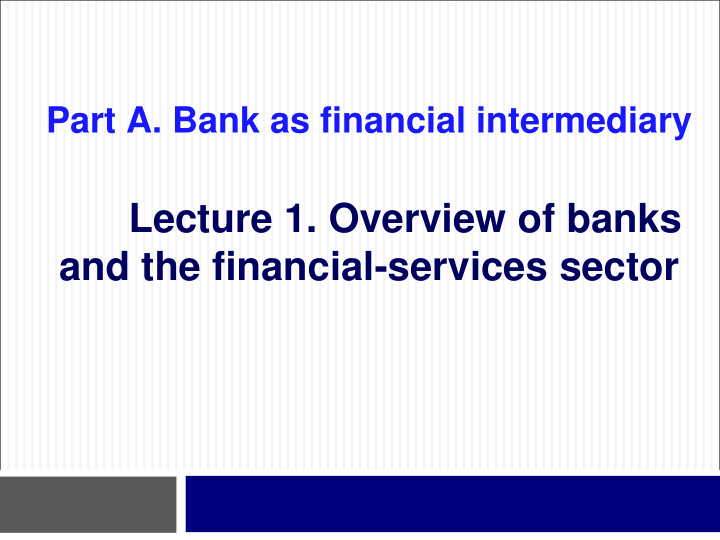



Part A. Bank as financial intermediary Lecture 1. Overview of banks and the financial-services sector
Objectives 2 (1) The role and functions of the financial system (2) The role of banks as financial intermediaries
(1) The role and functions of the financial system 3 Motivation Credit is essential in the modern economy: Individuals (consumer loans, real estate loans); Companies (working capital loans, investment loans); Governments (covering the budget deficit, investments).
(1) The role and functions of the financial system 4 Funding sources Bank loans Banking system (predominates in Romania) Stocks and Bonds Capital markets (predominates in USA)
(1) The role and functions of the financial system 5 The concept of financial system covers: A. Financial Markets B. Financial intermediaries C. Financial services firms D. Financial institutions … which implements the financial decisions of households (individuals), firms and governments (as representatives of the states).
(1) The role and functions of the financial system 6 The most important component of the financial system A. is the financial market , the meeting point of supply and demand for a wide range of financial assets: stocks and bond s (securities) financial derivatives homogeneous commodities (such as oil, grain, steel, aluminum, gold) currencies (Forex)
(1) The role and functions of the financial system 7 B. Financial intermediaries – specialized firms like: Banks Investment funds Insurance companies
(1) The role and functions of the financial system 8 C. Specialized financial services firms such as: Brokerage firms (in Romania, the technical name is SSIF) Consulting firms Rating agencies Audit firms
(1) The role and functions of the financial system 9 D. Regulatory and supervisory institutions @ national level: National Bank of Romania (BNR) for the banking market Financial Supervisory Authority (ASF) for the stock market, insurance companies and private pension system
(1) The role and functions of the financial system 10 D. Regulatory and supervisory institutions @ international level: European Central Bank (ECB) Bank of International Settlements Financial Stability Board
(1) The role and functions of the financial system 11 The role of the financial system: connecting units of capital surplus (U +) with those in deficit (U-) , regardless of type (households, firms, governments) or the geographical location directly through financial markets, without the contribution of an intermediary; indirectly through financial intermediaries. => Efficient allocation of capital !!!
(1) The role and functions of the financial system 12 Direct finance Barriers: 1) the difficulty and expense of matching the complex needs of individual borrowers and lenders; 2) the incompatibility of the financial needs of borrowers and lenders: - lenders want to lend their assets for short periods of time and for the highest possible return; - borrowers demand liabilities that are cheap and for long periods.
(1) The role and functions of the financial system 13 The intermediation function
(1) The role and functions of the financial system 14 Direct and indirect finance
(1) The role and functions of the financial system 15 Modern financial intermediation
(1) The role and functions of the financial system 16 Financial system functions: a) transferring resources in space and time; b) concentrating resources and assuring their divisibilit y; c) clearing and settlement of payments of a commercial nature; d) risk management; e) advice for financial decisions; f) addressing motivation and asymmetric information (adverse selection, moral hazard).
(2) The role of banks as financial intermediaries 17 Banks are financial intermediaries which core activity is to provide loans to borrowers and to collect deposits from savers . Deposits: small-size, low-risk and high-liquidity; Loans: larger-size, higher-risk and illiquid.
(2) The role of banks as financial intermediaries 18 Banks meet three essential functions: size transformation savers/depositors are willing to lend smaller amounts of money than the amounts required by borrowers; maturity transformation banks transform funds lent for a short period of time into medium- and long-term loans; risk transformation banks are able to minimise the risk of individual loans by diversifying their investments, pooling risks, screening and monitoring borrowers and holding reserves for unexpected losses.
(2) The role of banks as financial intermediaries 19 Distribution of assets in the Romanian financial sector (2016 Q2)
(2) The role of banks as financial intermediaries 20 Structure of the Romanian financial system (assets as a share of GDP)
(2) The role of banks as financial intermediaries 21 Relative sizes of banking and non‐bank financial sectors in CEE countries
(2) The role of banks as financial intermediaries 22 The share of exposures to and funds raised from domestic financial institutions in the balance sheet of credit institutions
(2) The role of banks as financial intermediaries 23 The share of exposures to credit institutions in the assets of financial sectors
Recommend
More recommend